Complete Solutions to QUESTIONS AND ANSWERS of chapter HOW DO ORGANISMS REPRODUCE? of Class 10 book with complete answers and questions
| Class 10 | BIOLOGY |
| Chapter | HOW DO ORGANISMS REPRODUCE? |
| KUMAR PRAKASHAN | QUESTIONS AND ANSWERS |
| Number Of Questions | 89 |
| Academic Year | 2023-24 |
Why do organisms reproduce ?
View SolutionReproduction is essential phenomenon that is not for survival of an individual. Explain.
View SolutionWhy do organisms of same species look similar ?
View SolutionHow do organisms create exact copies of themselves through reproduction ?
View SolutionWhy the creation of only DNA copy is not sufficient for cell division ?
View SolutionExplain : Cell reproduction
View SolutionExplain cell reproduction and tendency for variation inbuilt during cell reproduction.
View SolutionVariation is useful for survival of each species. Explain.
View SolutionHow is variation necessary for existence of each species ? Explain with example.
View SolutionWhat is the importance of DNA copying in reproduction ?
View SolutionWhy is variation beneficial to the species but not necessarily for the individual ?
View SolutionTo observe the asexual reproduction method-Budding in yeast.
Apparatus : Test tube, conical flask, cotton plug, cover slip, glass slide, microscope, dropper.
Materials : Water, sugar, dry yeast granules.
Procedure :
`rarr` Take 100mL of water in conical flask, Add 10g sugar and dissolve it to prepare sugar solution.
`rarr` Take 20mL of sugar solution in glass test tube. Add little amount of dry yeast granules. Shake the mixture and close the test tube tightly with cotton plug.
`rarr` Keep the test tube in warm place for 1 to 2 hours.
`rarr` Take one or two drops of yeast solution on the glass slide with the help of dropper.
`rarr` Now put a cover slip over it and observe under the microscope.

What is seen under the microscope?
View SolutionTo observe the asexual reproduction method-Budding in yeast.
Apparatus : Test tube, conical flask, cotton plug, cover slip, glass slide, microscope, dropper.
Materials : Water, sugar, dry yeast granules.
Procedure :
`rarr` Take 100mL of water in conical flask, Add 10g sugar and dissolve it to prepare sugar solution.
`rarr` Take 20mL of sugar solution in glass test tube. Add little amount of dry yeast granules. Shake the mixture and close the test tube tightly with cotton plug.
`rarr` Keep the test tube in warm place for 1 to 2 hours.
`rarr` Take one or two drops of yeast solution on the glass slide with the help of dropper.
`rarr` Now put a cover slip over it and observe under the microscope.

Explain meaning of Bud.
View SolutionTo observe the asexual reproduction method-Budding in yeast.
Apparatus : Test tube, conical flask, cotton plug, cover slip, glass slide, microscope, dropper.
Materials : Water, sugar, dry yeast granules.
Procedure :
`rarr` Take 100mL of water in conical flask, Add 10g sugar and dissolve it to prepare sugar solution.
`rarr` Take 20mL of sugar solution in glass test tube. Add little amount of dry yeast granules. Shake the mixture and close the test tube tightly with cotton plug.
`rarr` Keep the test tube in warm place for 1 to 2 hours.
`rarr` Take one or two drops of yeast solution on the glass slide with the help of dropper.
`rarr` Now put a cover slip over it and observe under the microscope.

Can yeast live in the dormant condition ?
View SolutionTo observe the growth of fungus-Rhizopus on the piece of bread.
Apparatus : Petridish, Magnifying glass.
Material : Wet slice of bread.
Procedure :
`rarr` Wet a slice of bread in water. Now put the wet plece of bread in petridish. Keep the petridish in dark, moist and cool environment for a week.
`rarr` Now observe the bread slice with help of magnifying glass.

What is seen on the slice of bread ?
View SolutionTo observe the growth of fungus-Rhizopus on the piece of bread.
Apparatus : Petridish, Magnifying glass.
Material : Wet slice of bread.
Procedure :
`rarr` Wet a slice of bread in water. Now put the wet plece of bread in petridish. Keep the petridish in dark, moist and cool environment for a week.
`rarr` Now observe the bread slice with help of magnifying glass.

What is seen on the slice of bread ?
View SolutionTo observe the growth of fungus-Rhizopus on the piece of bread.
Apparatus : Petridish, Magnifying glass.
Material : Wet slice of bread.
Procedure :
`rarr` Wet a slice of bread in water. Now put the wet plece of bread in petridish. Keep the petridish in dark, moist and cool environment for a week.
`rarr` Now observe the bread slice with help of magnifying glass.
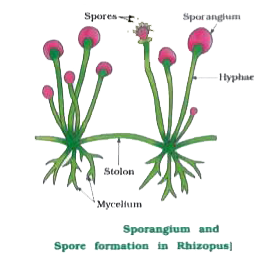
Which fungi grow on the bread ?
View SolutionTo observe the growth of fungus-Rhizopus on the piece of bread.
Apparatus : Petridish, Magnifying glass.
Material : Wet slice of bread.
Procedure :
`rarr` Wet a slice of bread in water. Now put the wet plece of bread in petridish. Keep the petridish in dark, moist and cool environment for a week.
`rarr` Now observe the bread slice with help of magnifying glass.
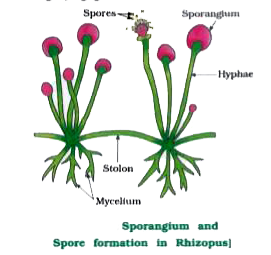
Why do spores of fungi germinate on the bread ?
View SolutionTo observe the growth of fungus-Rhizopus on the piece of bread.
Apparatus : Petridish, Magnifying glass.
Material : Wet slice of bread.
Procedure :
`rarr` Wet a slice of bread in water. Now put the wet plece of bread in petridish. Keep the petridish in dark, moist and cool environment for a week.
`rarr` Now observe the bread slice with help of magnifying glass.
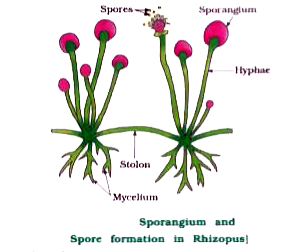
Reproduction through spore formation is which type of reproduction method ?
View SolutionTo observe the growth of fungus-Rhizopus on the piece of bread.
Apparatus : Petridish, Magnifying glass.
Material : Wet slice of bread.
Procedure :
`rarr` Wet a slice of bread in water. Now put the wet plece of bread in petridish. Keep the petridish in dark, moist and cool environment for a week.
`rarr` Now observe the bread slice with help of magnifying glass.
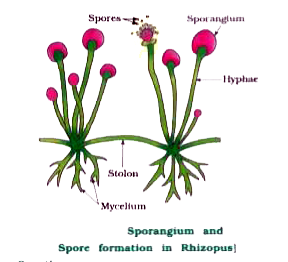
Compare the growth of yeast and mould.
View SolutionWhat is fission? Explain different types of fission.
View SolutionExplain the types of simplest method of asexual reproduction in unicellular organisms.
View SolutionTo observe binary fission in Amoeba.
Apparatus: Microscope, permanent slide of Amoeba.
Procedure :
`rarr` Observe a permanent slide of Amoeba under a microscope.
`rarr` Observe another permanent slide of Amoeba showing binary fission.
`rarr` Compare your observations in both the slides.
Is Amoeba prokaryotic or eukaryotic organism ?
View SolutionTo observe binary fission in Amoeba.
Apparatus: Microscope, permanent slide of Amoeba.
Procedure :
`rarr` Observe a permanent slide of Amoeba under a microscope.
`rarr` Observe another permanent slide of Amoeba showing binary fission.
`rarr` Compare your observations in both the slides.
Can you give the sequence of binary fission in Amoeba ?
View SolutionTo observe binary fission in Amoeba.
Apparatus: Microscope, permanent slide of Amoeba.
Procedure :
`rarr` Observe a permanent slide of Amoeba under a microscope.
`rarr` Observe another permanent slide of Amoeba showing binary fission.
`rarr` Compare your observations in both the slides.
Which unicellular, eukaryotic organisms reproduce through binary fission ?
View SolutionTo observe filamentous algae under microscope.
Apparatus : Microscope, slide, coverslip.
Materials : Glycerine, pond water, blotting paper.
Procedure :
`rarr` Collect water from a lake or pond that appears dark green and contains filamentous structure.
`rarr` Put one or two filaments on a slide.
Put a drop of glycerine on the filaments and cover it with a coverslip.
`rarr` Observe the slide under a microscope.

State the example of filamentous organism.
View SolutionTo observe filamentous algae under microscope.
Apparatus : Microscope, slide, coverslip.
Materials : Glycerine, pond water, blotting paper.
Procedure :
`rarr` Collect water from a lake or pond that appears dark green and contains filamentous structure.
`rarr` Put one or two filaments on a slide.
Put a drop of glycerine on the filaments and cover it with a coverslip.
`rarr` Observe the slide under a microscope.
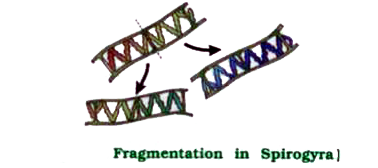
Can you identify different tissues in the filaments ?
View SolutionTo observe filamentous algae under microscope.
Apparatus : Microscope, slide, coverslip.
Materials : Glycerine, pond water, blotting paper.
Procedure :
`rarr` Collect water from a lake or pond that appears dark green and contains filamentous structure.
`rarr` Put one or two filaments on a slide.
Put a drop of glycerine on the filaments and cover it with a coverslip.
`rarr` Observe the slide under a microscope.
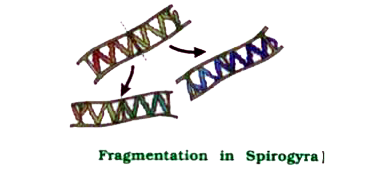
Why is filament of spirogyra green in colour ?
View SolutionTo observe filamentous algae under microscope.
Apparatus : Microscope, slide, coverslip.
Materials : Glycerine, pond water, blotting paper.
Procedure :
`rarr` Collect water from a lake or pond that appears dark green and contains filamentous structure.
`rarr` Put one or two filaments on a slide.
Put a drop of glycerine on the filaments and cover it with a coverslip.
`rarr` Observe the slide under a microscope.
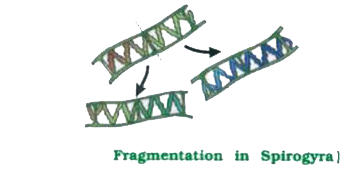
Is spirogyra a prokaryotic or eukaryotic organism ?
View SolutionTo observe filamentous algae under microscope.
Apparatus : Microscope, slide, coverslip.
Materials : Glycerine, pond water, blotting paper.
Procedure :
`rarr` Collect water from a lake or pond that appears dark green and contains filamentous structure.
`rarr` Put one or two filaments on a slide.
Put a drop of glycerine on the filaments and cover it with a coverslip.
`rarr` Observe the slide under a microscope.

How do spirogyra reproduce asexually ?
View SolutionWrite note on : Fragmentation
View SolutionExplain why fragmentation reproductive method can work for few but not all multi-cellular organisms.
View SolutionExplain the need to use more complex ways of reproduction for most of multi-cellular organisms.
View SolutionIs regeneration a type of reproduction ? Explain with example.
View SolutionWrite short note on : Budding
View SolutionWhat is vegetative propagation ? State the advantages of it.
View SolutionTo study the vegetative propagation in potato.
Apparatus : Tray, cotton
Material : Potato
Procedure :
`rarr` Take potato tuber and observe its surface.
`rarr` Observe the pits on its surface and bud present in the pit.
`rarr` Make circle around them with the help of marker.
`rarr` Cut the potato into small pieces in such a way that, some of them possess bud.
`rarr` Now put wet cotton in the tray and put the potato pieces on it.
`rarr` Water for some days in tray, so that cotton remains wet.
`rarr` Observe the changes that occur in the potato piece.

Is potato tuber root or stem?
View SolutionTo study the vegetative propagation in potato.
Apparatus : Tray, cotton
Material : Potato
Procedure :
`rarr` Take potato tuber and observe its surface.
`rarr` Observe the pits on its surface and bud present in the pit.
`rarr` Make circle around them with the help of marker.
`rarr` Cut the potato into small pieces in such a way that, some of them possess bud.
`rarr` Now put wet cotton in the tray and put the potato pieces on it.
`rarr` Water for some days in tray, so that cotton remains wet.
`rarr` Observe the changes that occur in the potato piece.
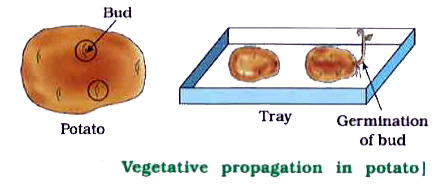
Which other plants except potato produce buds for vegetative propagation ?
View SolutionTo study the vegetative propagation in potato.
Apparatus : Tray, cotton
Material : Potato
Procedure :
`rarr` Take potato tuber and observe its surface.
`rarr` Observe the pits on its surface and bud present in the pit.
`rarr` Make circle around them with the help of marker.
`rarr` Cut the potato into small pieces in such a way that, some of them possess bud.
`rarr` Now put wet cotton in the tray and put the potato pieces on it.
`rarr` Water for some days in tray, so that cotton remains wet.
`rarr` Observe the changes that occur in the potato piece.
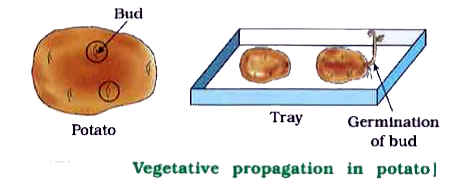
Which are the potato pieces, that give rise to fresh green shoots and roots ?
View SolutionTo show vegetative propagation by stem cuttings.
Materials : Money-plant (pothos)
Procedure:
`rarr` Select a money-plant. Cut some pieces which contain at least one node of leaf.
`rarr` Cut out some other portions between two leaves.
`rarr` Dip one end of all the pieces in water.
`rarr` Observe over the next few days.
Which pieces grow and give rise to fresh leaves ?
View SolutionTo show vegetative propagation by stem cuttings.
Materials : Money-plant (pothos)
Procedure:
`rarr` Select a money-plant. Cut some pieces which contain at least one node of leaf.
`rarr` Cut out some other portions between two leaves.
`rarr` Dip one end of all the pieces in water.
`rarr` Observe over the next few days.
Observe over the next few days.
State your conclusion.
View SolutionTo show vegetative propagation by stem cuttings.
Materials : Money-plant (pothos)
Procedure:
`rarr` Select a money-plant. Cut some pieces which contain at least one node of leaf.
`rarr` Cut out some other portions between two leaves.
`rarr` Dip one end of all the pieces in water.
`rarr` Observe over the next few days.
Can you give some other example to show vegetative propagation by stem cuttings ?
View SolutionExplain how, new Bryophyllum plants can be produced asexually ?
View SolutionWrite short note on : Tissue culture
View SolutionHow callus is developed and what is the use of callus ? Explain.
View SolutionWhat is a spore ? Explain asexual reproduction through spore formation.
View SolutionExplain asexual reproduction in Rhizopus.
View SolutionHow does binary fission differ from multiple fission ?
View SolutionHow will an organism be benefitted if it reproduces through spores ?
View SolutionCan you think of reasons why more complex organisms cannot give rise to new individuals through regeneration ?
View SolutionWhy is vegetative propagation practised for growing some types of plants ?
View SolutionWhy is DNA copying an essential part of the process of reproduction ?
View SolutionHow is sexual reproduction different from asexual reproduction ? State the limitations of asexual mode of reproduction.
View SolutionHow is the process of making variants be speed up through the sexual mode of reproduction ? Explain.
View SolutionHow is the number of chromosomes and the DNA content maintained constant generation after generation sexually reproducing organisms ?
View SolutionState the type and characteristics of germ cells.
View SolutionWhat is flower ? Explain reproductive parts of flower and types of flowers on the basis of it.
View SolutionExplain sexual reproduction in flowering plants.
View SolutionExplain all the events that occur for the development of seed from flower.
View SolutionTo observe the different parts of seed.
Materials : Seeds of Bengal gram (chana), water, wet cloth.
Procedure :
`rarr` Soak a few seeds of Bengal gram (chana) and keep them overnight.
`rarr` Drain the excess water and cover the seeds with a wet cloth and leave them for a day.
`rarr` Make sure that the seeds do not become dry.
`rarr` Cut open the seeds carefully and observe the different parts.

What is an embryo of plant ?
View SolutionTo observe the different parts of seed.
Materials : Seeds of Bengal gram (chana), water, wet cloth.
Procedure :
`rarr` Soak a few seeds of Bengal gram (chana) and keep them overnight.
`rarr` Drain the excess water and cover the seeds with a wet cloth and leave them for a day.
`rarr` Make sure that the seeds do not become dry.
`rarr` Cut open the seeds carefully and observe the different parts.
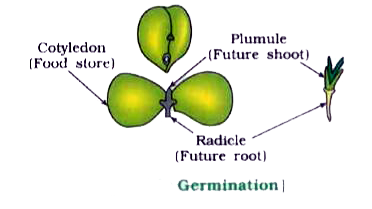
Which are the structures seen in an embryo?
View SolutionTo observe the different parts of seed.
Materials : Seeds of Bengal gram (chana), water, wet cloth.
Procedure :
`rarr` Soak a few seeds of Bengal gram (chana) and keep them overnight.
`rarr` Drain the excess water and cover the seeds with a wet cloth and leave them for a day.
`rarr` Make sure that the seeds do not become dry.
`rarr` Cut open the seeds carefully and observe the different parts.
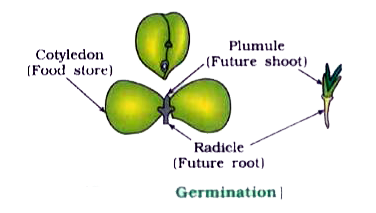
What is the role of cotyledon in chana ?
View SolutionTo observe the different parts of seed.
Materials : Seeds of Bengal gram (chana), water, wet cloth.
Procedure :
`rarr` Soak a few seeds of Bengal gram (chana) and keep them overnight.
`rarr` Drain the excess water and cover the seeds with a wet cloth and leave them for a day.
`rarr` Make sure that the seeds do not become dry.
`rarr` Cut open the seeds carefully and observe the different parts.
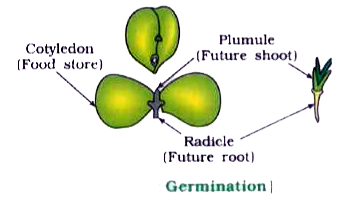
Which parts in seed are known as future root and as future shoot ?
View SolutionTo observe the different parts of seed.
Materials : Seeds of Bengal gram (chana), water, wet cloth.
Procedure :
`rarr` Soak a few seeds of Bengal gram (chana) and keep them overnight.
`rarr` Drain the excess water and cover the seeds with a wet cloth and leave them for a day.
`rarr` Make sure that the seeds do not become dry.
`rarr` Cut open the seeds carefully and observe the different parts.
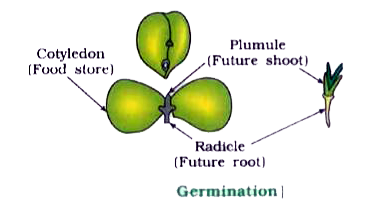
How is an embryo formed from zygote ?
View SolutionWhat is Puberty? Give common and sexual changes that occur during the puberty.
View SolutionWrite short note on: Puberty
View SolutionNote down the secondary sexual changes that occur in girls and boy's during the puberty.
View SolutionHow do transfer of germ cells occur between two individuals for sexual reproduction ?
View SolutionDescribe with diagram : Human - male reproductive system
View SolutionExplain in details : Male reproductive system
View SolutionExplain testes and male gametes.
View SolutionWrite short note on female reproductive system.
View SolutionExplain : Female reproductive system in human
View SolutionExplain how does embryo form and how does child birth occur in female.
View SolutionExplain processes of implantation of embryo till child birth.
View SolutionWrite short note on Placenta.
View SolutionExplain menstruation.
View SolutionWhat happens if the egg is not fertilised in woman ?
View SolutionWhat different kinds of pressures on individuals related to sexual maturation ? Why ?
View SolutionWhat are sexually transmitted diseases (STD) ?
View SolutionDescribe the methods for population control.
View SolutionExplain:Contraceptive methods
View SolutionExplain the scientific methods for population control.
View SolutionExplain in short: Population
View SolutionHow is the process of pollination different from fertilisation ?
View SolutionWhat is the role of the seminal vesicles and the prostate gland ?
View SolutionWhat are the changes seen in girls at the time of puberty ?
View SolutionHow does the embryo get nourishment inside the mother's body ?
View SolutionIf a woman is using a copper-T will it help in protecting her from sexually transmitted diseases ?
View Solution
QUESTIONS AND ANSWERS questions and complete solutions for chapter HOW DO ORGANISMS REPRODUCE? of KUMAR PRAKASHAN of Class 10
All Exercises from KUMAR PRAKASHAN Class 10 BIOLOGY HOW DO ORGANISMS REPRODUCE?
- ADDITIONAL QUESTIONS AND ANSWERS
- OBJECTIVE QUESTIONS AND ANSWERS
- OBJECTIVE QUESTIONS AND ANSWERS (Answer as directed : (Miscellaneous))
- OBJECTIVE QUESTIONS AND ANSWERS (Answer the following questions in short : )
- OBJECTIVE QUESTIONS AND ANSWERS (Define: OR Explain the terms: )
- OBJECTIVE QUESTIONS AND ANSWERS (Diagram based questions: )
- OBJECTIVE QUESTIONS AND ANSWERS (Fill in the blanks : )
- OBJECTIVE QUESTIONS AND ANSWERS (Select the correct option from those given below each question : )
- OBJECTIVE QUESTIONS AND ANSWERS (State whether the following statements are true or false: )
- PRACTICAL SKILL BASED QUESTIONS WITH ANSWERS
- QUESTIONS AND ANSWERS
- TEXTUAL EXERCISE
- VALUE BASED QUESTIONS WITH ANSWERS